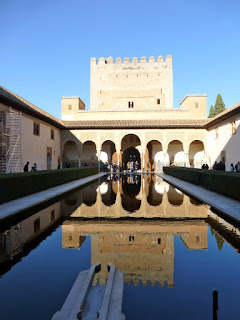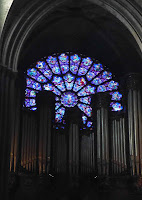Monday, December 31, 2012
Mas en Cordoba ...
Cordoba & The Mezquita . . .
Saturday, December 29, 2012
The Alhambra in Granada
1492 & Ferdinand & Isabella ...
Tuesday, December 25, 2012
A Memorable Christmas Day in Spain
Sunday, December 23, 2012
Madrid at Christmastime
Thursday, December 20, 2012
And then there was Chartres (Day #4) ...
Days 5-6 in Paris ...
Sunday, December 16, 2012
Day #2-3 in Paris
On Sunday morning, Dec. 16th, we took the Metro to the Eiffel Tower and since we had paid for tickets online, we had no trouble getting in and taking the elevator to the very top at the 9:30 a.m. opening of the tower. Pictured right below is a photo of the Arc de Triomphe taken from the top ... and also a picture taken from the top showing The Marine Museum and the Place du Trocadero across the Seine. Obviously, one cannot visit Paris without seeing the Eiffel Tower!
From the Eiffel Tower we took the Metro to the Notre Dame Cathedral where we attended an 11:30 a.m. worship service that was billed as "an international service" with some emphasis on English. It turned out that the service was almost entirely in French -- especially the homily -- so aside from being present in a spectacular edifice built for worship, there was definitely something lacking for us in terms of Christmas inspiration.Since the winter sun was shining brightly during much of the service, the stained glass windows could be seen in the best light. The famous West Rose Window (pictured) did not have the sun on it, but it was most impressive. From the church we walked to the Louvre, stopping en route for lunch. We spent about three hours inside the Louvre but obviously only scratched the surface in terms of what could be seen. I did like the picture I took of Nancy standing in front of the Mona Lisa!Doug and Tracy, Reeve, Gabi and Rania arrived in Paris early on Monday morning after their overnight flight from KL. Since they couldn't get into their apartment until afternoon, Nancy and I met them at "our Metro station" and escorted them to our apartment where we stored their luggage for several hours and fed them some breakfast. Then we accompanied them to the Eiffel Tower where I took the picture below. - rw
Subscribe to:
Posts (Atom)





















































